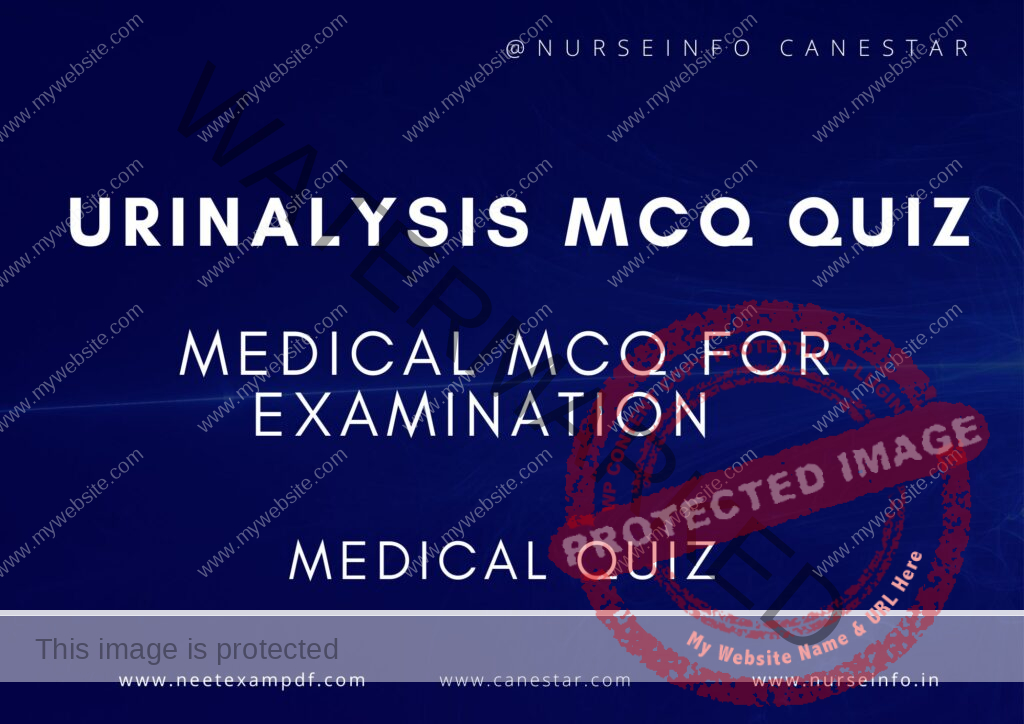MULTIPLE CHOICE QUESTIONS ON URINALYSIS QUIZ – MCQS WITH RATIONALE ANSWER – URINALYSIS MCQ QUESTIONS WITH RATIONALE
MCQ FOR URINALYSIS QUIZ
These mcqs are prepared exclusively for medical professionals for exam preparation. MCQ is helpful to remember the concept on urinalysis urine formation mcq quiz. This multiple choice questions are helpful for preparation for DHA, PROMETRIC, MOH, HAAD, NCLEX, Medical, NEET and Nursing EXAMINATION
URINALYSIS URINE FORMATION MCQ QUIZ
Urinalysis MCQs with Rationale
1. Which of the following is a normal finding in a urinalysis?
A. Presence of glucose
B. Presence of ketones
C. Presence of protein
D. Clear, pale yellow color
Answer: D. Clear, pale yellow color
Rationale: Normal urine is typically clear and pale yellow. The presence of glucose, ketones, or protein indicates an abnormal condition and requires further investigation.
2. The presence of nitrites in the urine typically indicates:
A. Dehydration
B. Liver disease
C. Bacterial infection
D. Renal stones
Answer: C. Bacterial infection
Rationale: Nitrites in the urine are typically a sign of bacterial infection, particularly by Gram-negative bacteria like Escherichia coli, which can reduce nitrates to nitrites.
3. A patient’s urinalysis shows a high specific gravity. Which of the following conditions might this indicate?
A. Diabetes insipidus
B. Overhydration
C. Dehydration
D. Renal failure
Answer: C. Dehydration
Rationale: High specific gravity indicates concentrated urine, which can be a result of dehydration. In contrast, low specific gravity may indicate overhydration or impaired kidney function.
4. Which of the following findings in a urinalysis is most suggestive of glomerular disease?
A. Hematuria
B. Proteinuria
C. Pyuria
D. Glycosuria
Answer: B. Proteinuria
Rationale: Proteinuria, especially when significant, suggests glomerular disease as the glomeruli fail to properly filter proteins, allowing them to pass into the urine.
5. The presence of large numbers of squamous epithelial cells in the urine sample usually indicates:
A. Bladder infection
B. Contamination of the sample
C. Kidney stones
D. Renal failure
Answer: B. Contamination of the sample
Rationale: Large numbers of squamous epithelial cells usually indicate contamination from the skin or external genitalia, suggesting the sample may not be clean.
6. What does the presence of leukocyte esterase in a urinalysis indicate?
A. Diabetes
B. Liver disease
C. Urinary tract infection
D. Glomerulonephritis
Answer: C. Urinary tract infection
Rationale: Leukocyte esterase is an enzyme found in white blood cells (leukocytes). Its presence in urine indicates pyuria, which is typically associated with a urinary tract infection.
7. Which of the following substances, if found in urine, is most indicative of uncontrolled diabetes mellitus?
A. Hemoglobin
B. Bilirubin
C. Ketones
D. Urobilinogen
Answer: C. Ketones
Rationale: The presence of ketones in urine indicates that the body is breaking down fat for energy due to a lack of insulin, which is a sign of uncontrolled diabetes mellitus.
8. Hematuria is defined as the presence of:
A. White blood cells in urine
B. Red blood cells in urine
C. Protein in urine
D. Glucose in urine
Answer: B. Red blood cells in urine
Rationale: Hematuria is the presence of red blood cells in urine, which can be indicative of various conditions such as infection, trauma, or kidney stones.
9. In which of the following conditions would you most likely find bilirubin in the urine?
A. Hemolytic anemia
B. Liver disease
C. Diabetes insipidus
D. Dehydration
Answer: B. Liver disease
Rationale: Bilirubin in urine typically indicates liver disease or bile duct obstruction, as bilirubin is a byproduct of hemoglobin breakdown that should be processed by the liver.
10. Which of the following conditions is indicated by the presence of casts in urine?
A. Bladder infection
B. Kidney disease
C. Liver disease
D. Diabetes
Answer: B. Kidney disease
Rationale: The presence of casts in urine indicates kidney disease, as casts are formed in the renal tubules and can signify various renal conditions depending on the type of cast.
11. A positive test for urinary urobilinogen may suggest:
A. Hepatitis
B. Urinary tract infection
C. Dehydration
D. Diabetes insipidus
Answer: A. Hepatitis
Rationale: Urobilinogen is a product of bilirubin reduction. Elevated levels in urine may suggest liver conditions like hepatitis or hemolytic disorders.
12. The presence of which of the following in urine can indicate a renal tubular disorder?
A. Glucose
B. Amino acids
C. Leukocytes
D. Erythrocytes
Answer: B. Amino acids
Rationale: Amino acids in urine can indicate a renal tubular disorder, where the kidneys are unable to reabsorb amino acids properly, leading to their excretion in urine.
13. What does a positive result for the presence of crystals in the urine suggest?
A. Bacterial infection
B. Renal calculi
C. Liver failure
D. Diabetes mellitus
Answer: B. Renal calculi
Rationale: The presence of crystals in urine may suggest conditions that can lead to the formation of renal calculi (kidney stones), such as high concentrations of specific substances.
14. A urinalysis shows a pH of 8.0. This may be associated with which of the following conditions?
A. Diabetic ketoacidosis
B. Respiratory acidosis
C. Bacterial infection
D. Dehydration
Answer: C. Bacterial infection
Rationale: A high urine pH (alkaline urine) can be associated with bacterial infections, particularly those caused by urea-splitting organisms like Proteus mirabilis.
15. What does the presence of ketonuria indicate?
A. Excessive carbohydrate intake
B. Protein malnutrition
C. Fat metabolism
D. Hydration status
Answer: C. Fat metabolism
Rationale: Ketonuria indicates that the body is metabolizing fat for energy, which occurs in conditions such as uncontrolled diabetes, starvation, or low-carbohydrate diets.
16. Which of the following is not typically detected in a routine urinalysis?
A. Glucose
B. Red blood cells
C. White blood cells
D. Sodium
Answer: D. Sodium
Rationale: Sodium is not typically measured in a routine urinalysis. Glucose, red blood cells, and white blood cells are part of the standard tests included in urinalysis.
17. A positive test for glucose in the urine usually indicates:
A. Hypoglycemia
B. Hyperglycemia
C. Hypernatremia
D. Hyponatremia
Answer: B. Hyperglycemia
Rationale: Glucose in the urine (glucosuria) typically indicates hyperglycemia, which occurs when blood glucose levels exceed the renal threshold for glucose reabsorption.
18. The presence of which of the following in a urinalysis can indicate a breakdown of muscle tissue?
A. Hemoglobin
B. Myoglobin
C. Bilirubin
D. Urea
Answer: B. Myoglobin
Rationale: Myoglobin in urine can indicate rhabdomyolysis, a condition involving muscle tissue breakdown that releases myoglobin into the bloodstream and subsequently into the urine.
19. The best method to collect a urine sample for culture in a patient with suspected urinary tract infection is:
A. Clean-catch midstream
B. First morning urine
C. Random urine sample
D. 24-hour urine collection
Answer: A. Clean-catch midstream
Rationale: A clean-catch midstream sample is preferred for urine culture to minimize contamination and provide an accurate representation of the pathogens present in the urinary tract.
20. In a urinalysis, the presence of which of the following substances is considered abnormal and requires further investigation?
A. Urobilinogen
B. Creatinine
C. Protein
D. Urea
Answer: C. Protein
Rationale: Protein in the urine (proteinuria) is considered abnormal and may indicate kidney disease or other conditions affecting renal function, necessitating further investigation.


